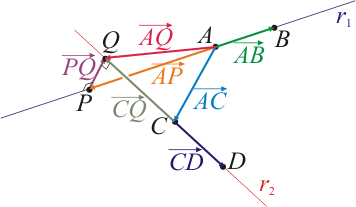Diferencia entre revisiones de «No Boletín - Cálculo de distancia entre dos rectas»
(Página creada con «==Enunciado== Sean las rectas <math>r_1</math>, que pasa por los puntos <math>A(-2,5,1)</math> y <math>B(7,-7,1)</math>, y <math>r_2</math> que pasa por <math>C(5,4,-3)</math> y <math>D(5,4,2)</math> (todas las unidades en el SI). Empleando el álgebra vectorial, determine la distancia entre estas dos rectas. ==Solución== right La distancia entre dos rectas es la correspondiente a la que hay entre los puntos más próximos de…») |
|||
| (No se muestran 2 ediciones intermedias del mismo usuario) | |||
| Línea 11: | Línea 11: | ||
Si <math>P</math> pertenece a la recta <math>r_1</math>, se cumple | Si <math>P</math> pertenece a la recta <math>r_1</math>, se cumple | ||
<center><math>\overrightarrow{AP}=\lambda\overrightarrow{AB}</math></center> | <center><math>\overrightarrow{AP}=\lambda\,\overrightarrow{AB}</math></center> | ||
y si <math>Q</math> pertenece a <math>r_2</math> | y si <math>Q</math> pertenece a <math>r_2</math> | ||
<center><math>\overrightarrow{CQ}=\mu\overrightarrow{CD}</math></center> | <center><math>\overrightarrow{CQ}=\mu\,\overrightarrow{CD}</math></center> | ||
El vector de posición relativo entre ambos puntos será | El vector de posición relativo entre ambos puntos será | ||
<center><math>\overrightarrow{PQ}=\overrightarrow{AQ}-\overrightarrow{AP}=\overrightarrow{AC}+\overrightarrow{CQ}-\overrightarrow{AP}=\overrightarrow{AC}+\mu\overrightarrow{CD}-\lambda\overrightarrow{AB}</math></center> | <center><math>\overrightarrow{PQ}=\overrightarrow{AQ}-\overrightarrow{AP}=\overrightarrow{AC}+\overrightarrow{CQ}-\overrightarrow{AP}=\overrightarrow{AC}+\mu\,\overrightarrow{CD}-\lambda\,\overrightarrow{AB}</math></center> | ||
Este vector debe ser ortogonal tanto al vector <math>\overrightarrow{AB}</math> como al vector <math>\overrightarrow{CD}</math> y por tanto será paralelo al producto vectorial de ambos | Este vector debe ser ortogonal tanto al vector <math>\overrightarrow{AB}</math> como al vector <math>\overrightarrow{CD}</math> y por tanto será paralelo al producto vectorial de ambos | ||
<center><math>\overrightarrow{PQ}=\nu(\overrightarrow{AB}\times\overrightarrow{CD})</math></center> | <center><math>\overrightarrow{PQ}=\nu\,(\overrightarrow{AB}\times\overrightarrow{CD})</math></center> | ||
La distancia entre las rectas será el módulo de este vector | La distancia entre las rectas será el módulo de este vector | ||
| Línea 31: | Línea 31: | ||
Por tanto, solo necesitamos hallar el parámetro <math>\nu</math>. Igualando las dos expresiones para el vector <math>\overrightarrow{PQ}</math> | Por tanto, solo necesitamos hallar el parámetro <math>\nu</math>. Igualando las dos expresiones para el vector <math>\overrightarrow{PQ}</math> | ||
<center><math>\nu(\overrightarrow{AB}\times\overrightarrow{CD}) = \overrightarrow{AC}+\mu\overrightarrow{CD}-\lambda\overrightarrow{AB}</math></center> | <center><math>\nu\,(\overrightarrow{AB}\times\overrightarrow{CD}) = \overrightarrow{AC}+\mu\,\overrightarrow{CD}-\lambda\,\overrightarrow{AB}</math></center> | ||
Multiplicando escalarmente por <math>\overrightarrow{AB}\times\overrightarrow{CD}</math> nos queda simplemente | Multiplicando escalarmente por <math>\overrightarrow{AB}\times\overrightarrow{CD}</math> nos queda simplemente | ||
<center><math>\nu \left|\overrightarrow{AB}\times\overrightarrow{CD}\right|^2 = \overrightarrow{AC}\cdot(\overrightarrow{AB}\times\overrightarrow{CD})</math></center> | <center><math>\nu\, \left|\overrightarrow{AB}\times\overrightarrow{CD}\right|^2 = \overrightarrow{AC}\cdot(\overrightarrow{AB}\times\overrightarrow{CD})</math></center> | ||
y por tanto la distancia que buscamos es | y por tanto la distancia que buscamos es | ||
| Línea 45: | Línea 45: | ||
Sustituyendo los valores tenemos | Sustituyendo los valores tenemos | ||
<center><math>\overrightarrow{AB}=(9\vec{\imath}-12\vec{\jmath})\,\mathrm{m}</math>{{qquad}}{{qquad}}<math>\overrightarrow{CD}=5\vec{k}\,\mathrm{m}</math>{{qquad}}{{qquad}}<math>\overrightarrow{AC}=(7\vec{\imath}-\vec{\jmath}-4\vec{k})\,\mathrm{m}</math></center> | <center><math>\overrightarrow{AB}=(9\vec{\imath}-12\vec{\jmath})\,\mathrm{m}\,;</math>{{qquad}}{{qquad}}{{qquad}}{{qquad}}<math>\overrightarrow{CD}=5\vec{k}\,\mathrm{m}\,;</math>{{qquad}}{{qquad}}{{qquad}}{{qquad}}<math>\overrightarrow{AC}=(7\vec{\imath}-\vec{\jmath}-4\vec{k})\,\mathrm{m}</math></center> | ||
Hallando los productos vectoriales y mixto | Hallando los productos vectoriales y mixto | ||
<center><math>\overrightarrow{AB}\times\overrightarrow{CD}=\left(-60\vec{\imath}-45\vec{\jmath}\right)\,\mathrm{m}^2</math>{{qquad}}{{qquad}}<math>\left|\overrightarrow{AB}\times\overrightarrow{CD}\right| = 75\,\mathrm{m}^2</math>{{qquad}}{{qquad}}<math>\overrightarrow{AC}\cdot(\overrightarrow{AB}\times\overrightarrow{CD}) = -375\,\mathrm{m}^3</math></center> | <center><math>\overrightarrow{AB}\times\overrightarrow{CD}=\left(-60\vec{\imath}-45\vec{\jmath}\right)\,\mathrm{m}^2\,;</math>{{qquad}}{{qquad}}{{qquad}}{{qquad}}<math>\left|\overrightarrow{AB}\times\overrightarrow{CD}\right| = 75\,\mathrm{m}^2\,;</math>{{qquad}}{{qquad}}{{qquad}}{{qquad}}<math>\overrightarrow{AC}\cdot(\overrightarrow{AB}\times\overrightarrow{CD}) = -375\,\mathrm{m}^3</math></center> | ||
por lo que la distancia entre las rectas es | por lo que la distancia entre las rectas es | ||
Revisión actual - 14:51 9 ene 2024
Enunciado
Sean las rectas , que pasa por los puntos y , y que pasa por y (todas las unidades en el SI). Empleando el álgebra vectorial, determine la distancia entre estas dos rectas.
Solución

La distancia entre dos rectas es la correspondiente a la que hay entre los puntos más próximos de una y de otra. Estos dos puntos se encuentran sobre la perpendicular común a ambas rectas.
Se trata entonces de hallar la distancia entre dos puntos y tales que pertenece a , pertenece a y es ortogonal a los vectores directores de ambas rectas.
Si pertenece a la recta , se cumple
y si pertenece a
El vector de posición relativo entre ambos puntos será
Este vector debe ser ortogonal tanto al vector como al vector y por tanto será paralelo al producto vectorial de ambos
La distancia entre las rectas será el módulo de este vector
Por tanto, solo necesitamos hallar el parámetro . Igualando las dos expresiones para el vector
Multiplicando escalarmente por nos queda simplemente
y por tanto la distancia que buscamos es
Nótese que el resultado final no requiere localizar los puntos y sino que hemos llegado a una expresión para la distancia que solo depende de los cuatro puntos dados.
Sustituyendo los valores tenemos
Hallando los productos vectoriales y mixto
por lo que la distancia entre las rectas es



























